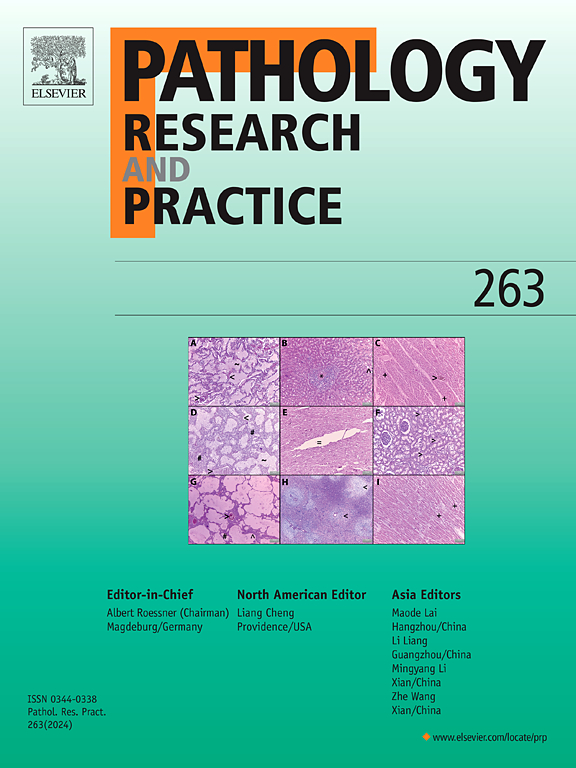MicroRNA-206 overexpression is associated with a prominent inflammatory reaction and a favorable colorectal cancer prognosis
IF 2.9
4区 医学
Q2 PATHOLOGY
引用次数: 0
Abstract
Background
MicroRNAs act as oncogenes or tumor suppressors in various cancers. The tumor microenvironment (TME) plays an important role in tumor cell progression and survival.
Methods
MicroRNA expressions were evaluated by using NanoString nCounter assay, qRT-PCR and in situ hybridization. Correlation between MircoRNA expressions and TME factors, clinicopathological behaviors and prognostic significance were assessed in 323 surgically resected colorectal cancers.
Results
The microRNA-206 expression was identified significantly higher in Glasgow microenvironment score (GMS) 0 than in GMS 1 or GMS 2 by using the NanoString nCounter assay and qRT-PCR. High microRNA-206 expression was identified in 155 (48.0 %) cases in in situ hybridization and was significantly correlated with low pT classification, and absence of lymphovascular and perineural invasion, and lymph node metastasis. MicroRNA-206 expression was significantly associated with low tumor stroma percentage (TSP), high Klintrup–Mäkinen (KM) grade and low GMS. Patients with high microRNA-206 expression showed significantly better 5-year overall survival than those with low microRNA-206 expression, and was an independent prognostic factor in patients with colorectal cancer. High miR-206 expression was associated with TME, favorable clinicopathologic behaviors and overall survival and presents an independent prognostic factor in patients with colorectal cancer.
Conclusion
Thus, MicroRNA-206 expression presents a feasible prognostic factor and potential therapeutic target to treat patients with colorectal cancer.
MicroRNA-206 的过表达与突出的炎症反应和良好的结直肠癌预后有关
背景MicroRNA在各种癌症中充当致癌基因或肿瘤抑制因子。方法 采用 NanoString nCounter 检测法、qRT-PCR 和原位杂交法评估微RNA的表达。结果 通过 NanoString nCounter 检测法和 qRT-PCR 法,发现格拉斯哥微环境评分(GMS)0 的 microRNA-206 表达明显高于 GMS 1 或 GMS 2。原位杂交发现,155 例(48.0%)病例存在 microRNA-206 高表达,且与低 pT 分级、无淋巴管和神经周围侵犯以及淋巴结转移显著相关。MicroRNA-206 的表达与低肿瘤基质百分比(TSP)、高克林特鲁普-迈基宁(KM)分级和低 GMS 显著相关。microRNA-206高表达患者的5年总生存期明显优于microRNA-206低表达患者,是结直肠癌患者的一个独立预后因素。miR-206的高表达与TME、良好的临床病理表现和总生存率相关,是结直肠癌患者的一个独立预后因素。
本文章由计算机程序翻译,如有差异,请以英文原文为准。
求助全文
约1分钟内获得全文
求助全文
来源期刊
CiteScore
5.00
自引率
3.60%
发文量
405
审稿时长
24 days
期刊介绍:
Pathology, Research and Practice provides accessible coverage of the most recent developments across the entire field of pathology: Reviews focus on recent progress in pathology, while Comments look at interesting current problems and at hypotheses for future developments in pathology. Original Papers present novel findings on all aspects of general, anatomic and molecular pathology. Rapid Communications inform readers on preliminary findings that may be relevant for further studies and need to be communicated quickly. Teaching Cases look at new aspects or special diagnostic problems of diseases and at case reports relevant for the pathologist''s practice.

 求助内容:
求助内容: 应助结果提醒方式:
应助结果提醒方式:


